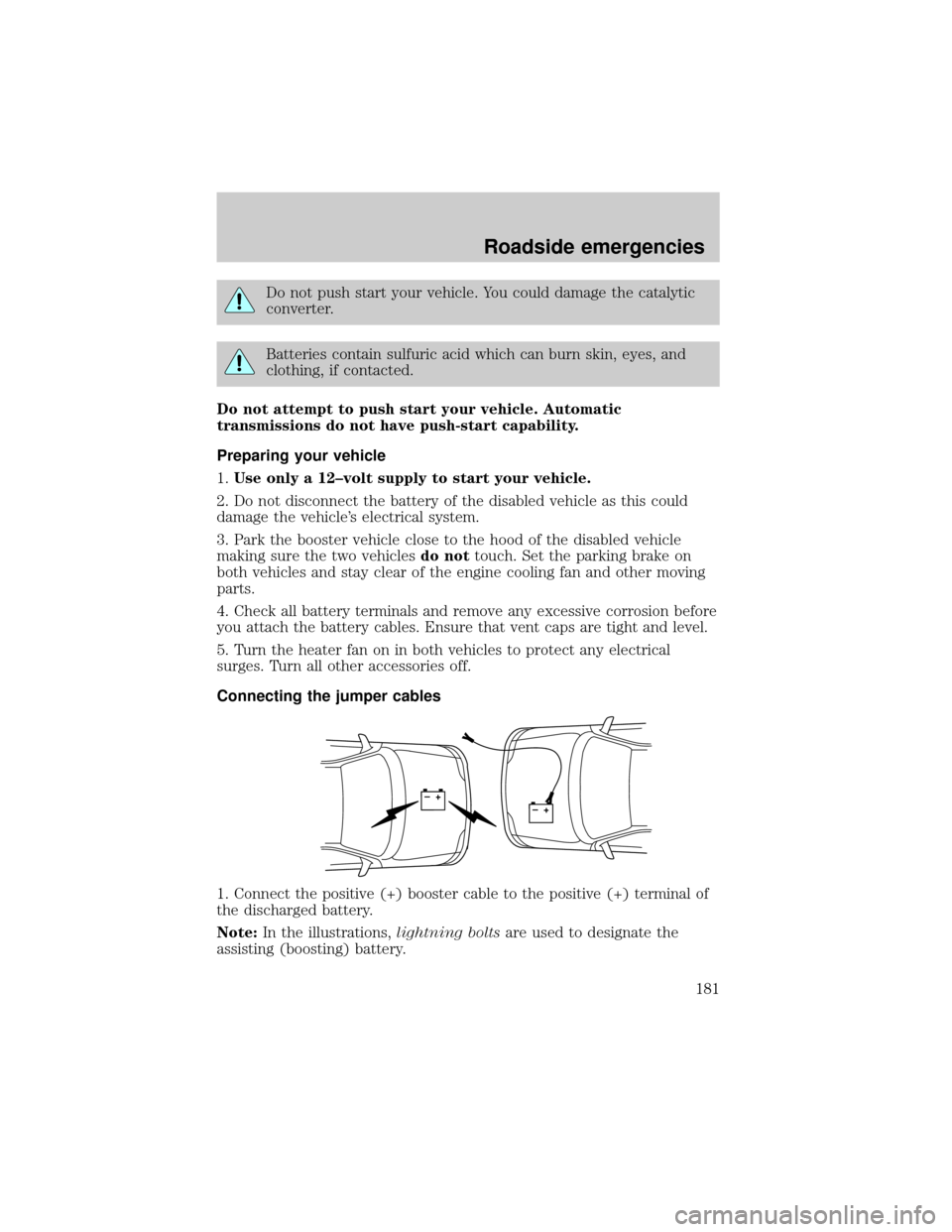heater Mercury Villager 2000 Owner's Manuals
[x] Cancel search | Manufacturer: MERCURY, Model Year: 2000, Model line: Villager, Model: Mercury Villager 2000Pages: 256, PDF Size: 2.21 MB
Page 150 of 256

seconds and try again. If the engine does not start in two attempts, Press
the accelerator pedal all the way to floor and hold. Turn the key to
START position.
4. When the engine starts, release the key, then release the accelerator
pedal gradually as the engine speeds up.
5. After idling for a few seconds, apply the brake and release the parking
brake.
Using the engine block heater (if equipped)
An engine block heater warms the engine coolant, which improves
starting, warms up the engine faster and allows the heater-defroster
system to respond quickly. Use of an engine block heater is strongly
recommended if you live in a region where temperatures reach -23ÉC
(-10ÉF) or below.
For best results, plug the heater in at least three hours before starting
the vehicle. Using the heater for longer than three hours will not harm
the engine, so the heater can be plugged in the night before starting the
vehicle.
To prevent electrical shock, do not use your heater with
ungrounded electrical systems or two-pronged (cheater)
adapters.
Guarding against exhaust fumes
Although odorless and colorless, carbon monoxide is present in exhaust
fumes. Take precautions to avoid its dangerous effects.
If you ever smell exhaust fumes of any kind inside your vehicle,
have your dealer inspect and fix your vehicle immediately. Do
not drive if you smell exhaust fumes. These fumes are harmful and
could kill you.
Have the exhaust and body ventilation systems checked whenever:
²the vehicle is raised for service.
²the sound of the exhaust system changes.
²the vehicle has been damaged in a collision.
Starting
150
Page 181 of 256

Do not push start your vehicle. You could damage the catalytic
converter.
Batteries contain sulfuric acid which can burn skin, eyes, and
clothing, if contacted.
Do not attempt to push start your vehicle. Automatic
transmissions do not have push-start capability.
Preparing your vehicle
1.Use only a 12±volt supply to start your vehicle.
2. Do not disconnect the battery of the disabled vehicle as this could
damage the vehicle's electrical system.
3. Park the booster vehicle close to the hood of the disabled vehicle
making sure the two vehiclesdo nottouch. Set the parking brake on
both vehicles and stay clear of the engine cooling fan and other moving
parts.
4. Check all battery terminals and remove any excessive corrosion before
you attach the battery cables. Ensure that vent caps are tight and level.
5. Turn the heater fan on in both vehicles to protect any electrical
surges. Turn all other accessories off.
Connecting the jumper cables
1. Connect the positive (+) booster cable to the positive (+) terminal of
the discharged battery.
Note:In the illustrations,lightning boltsare used to designate the
assisting (boosting) battery.
+–+–
Roadside emergencies
181
Page 247 of 256

Comfort and convenience
Cargo nets
Cargo organizers
Cargo trays
Electrochromic inside mirror with compass display
Electrochromic inside mirror with compass and temperature display
Engine block heaters
Gear shift knob
Seatback organizer
Tire step
Travel equipment
Auto headlamps with daytime running lights (DRL)
Console
Daytime running lights (DRL)
Factory luggage rack
Factory luggage rack adaptors
Framed luggage covers
Heavy-duty battery
Running boards, child step
Soft luggage cover
Track rider bars
Track rider bar adaptors
Trailer hitch (Class II)
Trailer hitch bars and balls
Protection and appearance equipment
Air bag anti-theft locks
Carpet floor mats
Cleaners, waxes and polishes
Flat splash guards
Front end covers (full and mini)
Customer assistance
247
Page 252 of 256

Clock ..................................48,60,71
Console ......................................101
overhead ....................................98
Controls
power seat ...............................113
steering column ........................86
Coolant
checking and adding ..............194
refill capacities .................197,233
specifications ...................234,235
Cruise control
(see Speed control) ....................82
Customer Assistance ................166
Ford accessories for your
vehicle .....................................245
Ford Extended
Service Plan ............................238
Getting assistance outside
the U.S. and Canada ..............244
Getting roadside assistance ...166
Getting the
service you need ....................238
Ordering additional
owner's literature ...................249
The Dispute
Settlement Board ...................241
Utilizing the Mediation/
Arbitration Program ...............244
Defrost
rear window ..............................40
Dipstick
automatic
transmission fluid ...................198
engine oil .................................189
Doors
door ajar warning .......................9
lubricant specifications ..........234
Driving under special
conditions
through water .........................159
Emergencies, roadside
jump-starting ..........................180Emission control system ..........220
Engine ........................................235
check engine/service engine
soon light ..................................11
cleaning ...................................229
coolant .....................................194
idle speed control ...................201
lubrication
specifications ...................234,235
refill capacities ........................233
service points ..........................188
starting after a collision .........167
Engine block heater .................150
Engine oil ..................................189
checking and adding ..............189
dipstick ....................................189
filter, specifications .........191,233
recommendations ...................191
refill capacities ........................233
specifications ...................234,235
Exhaust fumes ..........................150
Floor mats .................................102
Fluid capacities .........................233
Fuel ............................................212
calculating fuel economy .......217
cap ...........................................214
capacity ...................................233
choosing the right fuel ...........215
comparisons with EPA fuel
economy estimates .................220
detergent in fuel .....................216
filling your vehicle
with fuel ....................212,214,217
filter, specifications .........217,233
fuel pump shut-off switch .....167
gauge .........................................16
improving fuel economy ........217
low fuel warning light ..............10
octane rating ....................216,235
quality ......................................216
running out of fuel .................217
Index
252